Willow sculpture and craft – Sara Holmes expert willow sculptor answers 10 FAQ’s
Expert willow sculptor Sara Holmes answers 10 of her most FAQ’s about willow sculpting
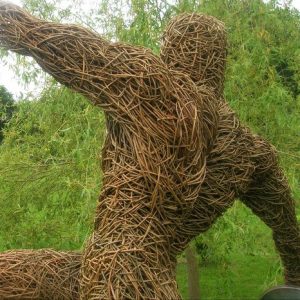
Over the many years my mother and I have been working with willow sculpture and craft we have noticed a lot of the same curious questions being asked. So we thought it would be helpful and useful for those of you who are interested in knowing more about this great craft to compile a list of some commonly asked questions. If you feel like you have more questions you’d like to ask us or you’d like something explained in a little bit more detail then please leave us a comment in the box and we’ll be more than happy to help you.
1. How long do willow sculptures last?
How long a willow sculpture lasts depends on a few things but anything between 3 and 6/7 years is reasonable to expect, depending on a few factors and sometimes longer than this if some or all of the following measures are possible.
Firstly the weather! A few long wet, damp winters followed by long periods of intense sunshine will take its toll on the willow withies. Another factor is the density of the weave which determines how much willow is in the sculpture- a very densely woven sculpture will last longer than one which is loosely woven or hollow.
Other influences such as where a sculpture is placed in a garden – a sculpture placed under a tree or in a very damp area of a garden will not last as long as one placed in a more open area where it can dry out after it has rained. If a sculpture is treated with a preservative such as teak oil or linseed oil this will help to preserve it for longer.
Another way to lengthen a willow sculptures lifespan is to bring it inside for the winter.
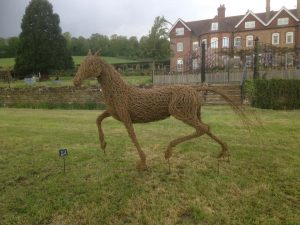
2. How long do willow sculptures take you to make?
Like everything we learn to do, with more practice and experience, we get faster at doing it. I have now been creating willow sculptures for 17 years. The very intricate and dense nature of the weave I have cultivated and honed over the years is time consuming and a method driven style. I can now for example, create something like a life size fallow deer, in about 2 to 3 days including the preparation and welding of the armature. This would have taken me about 5 or 6 days, possibly longer, a few years ago.
A less dense and intricate sculpture can be created in a day at one of my workshops where I share my sculpting methods and techniques. These techniques however, are better learnt and practiced over time at one’s own pace on one of my
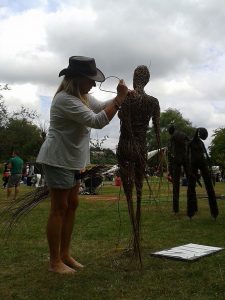
3. How much willow do you need to make a large sculpture?
How much willow is needed for a sculpture firstly depends on the size of the piece being created and secondly, the density of the weave. As an example the deer sculpture shown below is life size and made in my own style with a very dense weave. For this sculpture I used approximately 3 kilos of 5 ft (1.5m) rods and between 5 to 7 kilos of 4ft (1.2m) rods including a little wastage.
A beginner is likely to use less willow than this as their weave is unlikely to be as dense, so about half these amounts for a similar size sculpture.
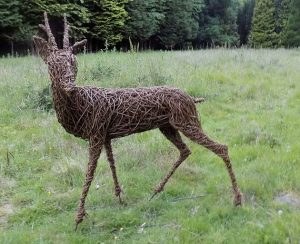
4. Why did you start making willow sculptures?
This is a question I am asked at every demo and every workshop! I have always been an artist. I have experimented with many mediums including paint, clay and textiles. I have always been drawn to weaving, sewing, threads and yarn. Nature and the environment have always been important to me and I was captivated by the long shoots I saw coming out of hedgerows and what I later learnt were coppiced and pollarded trees. I felt a need to utilize them as a medium. I then saw Serena De La Hay’s ‘Willow Man’ next to the M5 in Somerset and I was instantly inspired and motivated to try using it as a sculpture medium.
I went to a piece of heathland near my home where I’d seen willow growing in long shoots along the paths and gleaned armfuls of it not knowing what type of willow it was or anything about the correct times of year to harvest etc! Needless to say, it was not very successful as it was Crack willow, a wild variety no use for weaving and it was summer, the wrong time of year to harvest willow. I then decided it would be a good idea to do a little more research!
I found a willow supplier. I taught myself and invented my own techniques, there wasn’t anyone like me around then who ran courses.
I made my first sculpture, a unicorn (I was never one to start small!) I was extremely proud! Only, now in retrospect I do realize it was a very primitive attempt! I have been working with willow, honing my skills and techniques ever since. I’ve tried at various times, over the years to move away and on to new materials but it keeps coming back to me, it is now part of me and I’m often referred to as ‘the willowwoman’!

5. How long do you need to soak willow for before using it?
The general rule is to soak the willow rods for 24 hours per foot of willow, so 4ft (1.2m) willow should be soaked for 4 days and 4 nights. I usually add on an extra day for good measure. If the weather is really hot you might want to change the water half way through the soaking time as it can begin to stagnate and will cause the willow to ferment. If the weather is very cold cover with a tarp piece of old carpet to prevent the water from freezing as frozen water will damage the willow.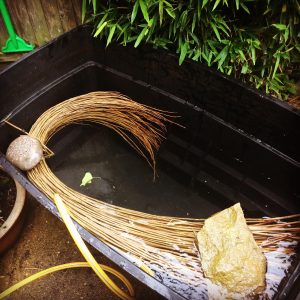
6. Do I need to make a metal frame for a sculpture?
I weld simple, mild steel armatures for many of my sculptures as I have found it to be very useful, giving it weight and stability while working and helping to hold the shape and form. As many of my sculptures are commissioned pieces it also helps to form a base for their eventual placement.
However, it is perfectly possible to create willow sculptures without welding an armature. You can still use the steel on figurative pieces for legs for example, using thicker willow rods or hazel poles and binding techniques to join them or simply use hazel or thicker willow and not use any steel at all. Mild steel rod can however be useful for legs, as you can bend it into the positions you want and it can be easily pushed into the ground for stability. Alternatives to welded armatures are taught as part of our .
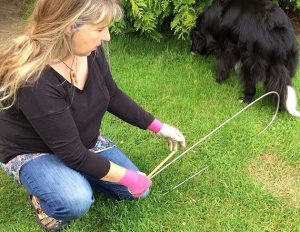
7. Can I use the willow growing in my garden?
There are literally hundreds of varieties of willow. Most of the varieties of willow I use for sculptures are cultivars and grown commercially for basketry and artist charcoal. It is likely that the willow you are familiar with or that’s growing in a garden is either a wild species or an ornamental such as weeping willow, which are not any use for the type of sculptures I create as they lack the strength and elasticity of other varieties specially cultivated for basketry and craft. Black Maul is a cultivar of a European species and is the one I use the most of for sculpture. When the bark is left on and it is dry it is referred to in the trade as ‘Brown’.
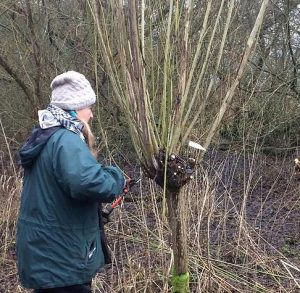
8. Do you grow your own willow?
I have started to grow a few willow stools in my garden however it would not be possible for me to grow the amount of willow I use in a year which amounts to at least a hundred kilos and I would need a few acres of land and a workforce and some specialist equipment to harvest it in the Spring! For personal use, for a hobby it would however be a great thing to do as you can grow species with colourful winter stems for your garden, which can then be harvested, ‘coppiced’ in the Spring to use for sculptures, living willow structures, basketry and craft.
You will also be providing habitat for wildlife and helping the environment. Good varieties to grow include Salix triandra for sculpture, basketry and craft; and Viminalis and Hybrid Red for living willow structures.
9. Where do you get your willow from?
I buy my willow mainly from growers in Somerset. These are my nearest suppliers. However, there are other growers in different parts of the country in the UK.Below I have listed the main suppliers in the UK.
If you are not in the UK I suggest you google ‘willow suppliers’ and provided you live in a temperate region of the Northern hemisphere it is likely that willow is being grown commercially somewhere, not too far away from you.
Most commercial growers are likely to sell willow in single kilos and deliver to your door.
https://www.musgrovewillows.co.uk/
http://www.englishwillowbaskets.co.uk/
http://www.willowgrowers.co.uk/
http://www.worldofwillow.co.uk/
http://www.willowwithies.co.uk/
http://www.yorkshirewillow.co.uk/
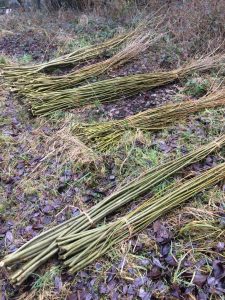
10. Will a sculpture start to grow?
The only type of willow sculpture that will grow, is one created from ‘living willow’. This is willow harvested during the Spring which can then be planted into the earth. This type of willow is used for living fences, arbours, arches, tunnels, domes (like the picture below) and sculptures and will sprout new growth and be very effective, especially if the new growth is considered in the design and managed well.
The type of sculptures I am mainly get involved in creating and teaching are made from coppiced willow which has been left to dry and is not intended for planting and is therefore no longer a live stem.


